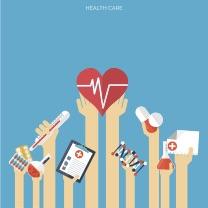 Wayne Sexton has Type 1 diabetes and is on an insulin pump. He’s also the deputy director of Procurement at a large London hospital Trust which is a centre of excellence for pumps, although he attends a diabetes clinic in another Trust for his own healthcare. He’s one of many people with diabetes who work in the NHS, but as he works in procurement, we thought we’d quiz him about what he thinks the NHS should be doing and what can be done to improve access to advanced technology for the treatment of diabetes.
Wayne Sexton has Type 1 diabetes and is on an insulin pump. He’s also the deputy director of Procurement at a large London hospital Trust which is a centre of excellence for pumps, although he attends a diabetes clinic in another Trust for his own healthcare. He’s one of many people with diabetes who work in the NHS, but as he works in procurement, we thought we’d quiz him about what he thinks the NHS should be doing and what can be done to improve access to advanced technology for the treatment of diabetes.
What’s it like working in Procurement for the NHS?
The NHS is big and unwieldy and it’s complex. People have an idea that it’s the commissioners who decide who has what equipment – things like pumps and sensors. But procurement as a function within the NHS is to ensure that tax-payers money is well spent and that what the trust is doing is compliant in legal terms. Procurement does not say what is or is not available, or if a person is or is not suitable for something like pump therapy, it’s the Clinical Team that decides.
People also assume that because I have diabetes and I work in procurement that I can order what I like for myself. That’s very far from the truth! I fought for years to get a pump, and I still can’t get funding for sensors to go with it. Put really simply, I want everyone to have everything that they need, but I also have to defend how we spend money. I believe in the NHS. I love working in it, although there is no actual NHS – each Trust is independent and operates with its own profit and loss, and a Foundation Trust has more flexibility than non-Foundation Trusts.
The numbers are big – the Trust I work for has an annual turnover of almost £1bn. Each Trust is run as a business and they are all run differently, which is why services vary.
We keep hearing about cuts in the NHS, and that people can’t get funding for pumps. What’s going on?
 The latest challenge from current politicians is to save £22bn by 2020, known as the Nicholson Challenge (see right). Meanwhile, the Government has promised £8bn – which means that overall it will keep us equal to today’s budget but with no new investment. The Trust I work for has to save £43m in this financial year (2015/2016).
The latest challenge from current politicians is to save £22bn by 2020, known as the Nicholson Challenge (see right). Meanwhile, the Government has promised £8bn – which means that overall it will keep us equal to today’s budget but with no new investment. The Trust I work for has to save £43m in this financial year (2015/2016).
One sector I pay close attention to is what we call Insulin Delivery Systems (or IDS). From a procurement point of view, there are only a few suppliers in this sector – Medtronic, Roche, Ypsomed, and a few others. Roughly, the insulin delivery systems do much the same thing. The NHS seems to continue to work on a 12-month basis in terms of budgets, yet people with diabetes average several decades of living with the condition. Added to that, often we – as people with diabetes – feel that we’re viewed only in terms of our HbA1c result and that we’re not considered as a person.
Are we as customers (or patients) the focus of the NHS? It’s hard to think so sometimes, but there are now more people who are working within the system for a better understanding of the bigger picture and of the entire lifespan of those of us with this long-term health condition. Our message is that quality of life also matters, not just test results.
How do you get that across?
A patient could have diabetes for 20, 40, 60 or even 80 years and will be engaged with the NHS through that whole period. What we’re trying to do is link the cost of long-term damage due to diabetes against up-front cost. The cost of NOT doing it – for example, denying someone access to a pump or a pump and sensors, or limiting Type 2s access to blood test strips – will see costs rise and rise on the future for each individual, and for the NHS as a whole. Getting the right care soonest means the least cost later.
As much as 80% of the NHS’s diabetes budget is spent on the treatment of complications brought on either by sub-optimal control or by longevity of having the condition. Only 20% is spent on meters, pumps, CGM and education – the actual tools that help us live with the condition and manage it to the best of our ability.
Recent studies have shown that cardiac damage is significantly reduced – by as much as 30% and mortality by 20% – if Type 1 diabetics are on insulin pumps. It’s simple – better equipment from the start will save additional cost in the future. It’s the additional cost that is expensive. The cost of a pump is nothing next to the cost of care such as dialysis, or hospital admissions to A&E. The average cost of a diabetic being taken to A&E for either a hypo or DKA is £1-2k. If it becomes an overnight stay it’s way more and if you come in with DKA it may take a few days to get stabilised, so it’s a big cost.
I’m working with a group of Trusts to help prove by results that better kit sooner is better all round. Pumps, sensors, tele-medicine all are proven to improve outcomes. It’s common sense that we should invest in them.
Why then do we face a challenge to get pump funding, especially pump+sensor funding?
 As deputy director of procurement, I do not have direct access to the CCGs but I, along with my clinical colleagues, can show that using better kit gives better control and leads to fewer complications. The NHS is like a sprawling metropolis, which is continuing to grow. NHS Supply Chain (NHS SC) is the biggest supplier into the NHS, supplying all things like gloves, syringes etc., The cost structures are immensely complex and can in fact sometimes prevent cost savings. NHS SC is partly owned by a government business division that also covers prescriptions. Any savings made go back into central government, not directly into the NHS.
As deputy director of procurement, I do not have direct access to the CCGs but I, along with my clinical colleagues, can show that using better kit gives better control and leads to fewer complications. The NHS is like a sprawling metropolis, which is continuing to grow. NHS Supply Chain (NHS SC) is the biggest supplier into the NHS, supplying all things like gloves, syringes etc., The cost structures are immensely complex and can in fact sometimes prevent cost savings. NHS SC is partly owned by a government business division that also covers prescriptions. Any savings made go back into central government, not directly into the NHS.
What should someone do if they want to get pump funding?
As patients, you need to look at the NICE Guidelines for pump funding. Everyone who wants to be should be on a pump. In the Netherlands they see far fewer cases of damage because they get full and early engagement. Pumps have been appraised as a business technology and the guidelines for adoption are there. The NICE Guidelines are designed to encourage more pump uptake in the UK.
In the meantime, sensor assessment is underway, making a business case to show their value. In my view, the whole package should be available, pumps with sensors if that is what is wanted or required. All of the solution is what improves the outcomes… not just a part of it, such as just the pump. See the INPUT site for more support and information. There is a Patient Constitution –– you have the right to be treated where you want, so you have the right to ask your GP to refer you to a diabetes clinic in hospital – i.e you do not have to stay under GP level care, and GPs are not qualified to say if you should go on a pump. You need referring to a specialist diabetes clinic.
Is it all about cost?
No, and it’s more than HbA1c results too. Procurement is not involved in decisions about who gets a pump, we are keen to encourage clinicians to work in a joined-up way to see the best results delivered. As I’ve said, I do not have the right to say ‘no’ if the clinician wants a patient to go on a pump, but it ought to be a rounded decision. I’m trying to make that the norm to prove that over a period of time the equipment is saving money in the long-term.
Contract review in the NHS is poor so contract management, linking pumps and sensors to fewer admissions for hypos and DKA (diabetic ketoacidosis) is what will make the argument go away. I hope that NHS England step into the pump therapy debate and put national contracts in place and that built into that would be the whole system – pump and sensors — then record results in care and show the benefits.
I would also say that if we’re heading towards a closed loop system of care in the future, then you have to go pump and sensor, or else it’s still the old thinking.
Trusts share best practice – evidence, experience — and work together to move towards improvements, so it is all possible. Technology is changing all the time. We have to keep learning and reassessing, talking, listening and change the mind-set of those who don’t get it.
Some people are being moved on to other blood test meters by their GP. What can they do?
Yes, there is a move at the moment for CCGs to do contracts with just two suppliers – they say, “you can have this one or that one”. This has distressed a lot of people. You need to contest the decision if you are not happy to be moved to another meter. Who sits on the CCGs? It’s GPs who need to save money for their practices. But challenge GPs; they can’t enforce this. Who are they to compromise your health? If you like and use your kit your health will be the best it can be. You can’t demand in the NHS. That just does not work. You can reason with them, and show that it’s not just about costs.



